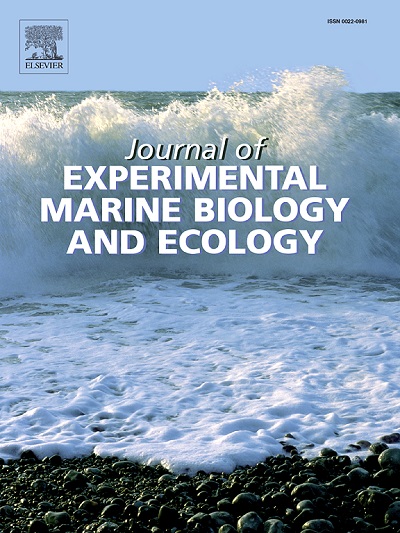Modeling growth of multiple recruitment cohorts of Dungeness crab co-occurring within the central Salish Sea
IF 1.8
3区 生物学
Q3 ECOLOGY
Journal of Experimental Marine Biology and Ecology
Pub Date : 2024-10-21
DOI:10.1016/j.jembe.2024.152064
引用次数: 0
Abstract
The carapace dimensions of Dungeness crab (Metacarcinus magister) at a given molt stage vary greatly throughout their range. Although growth models have been developed for various coastal Dungeness crab populations, the patterns of growth for juvenile Dungeness crab in the central Salish Sea remain largely unknown. Larval Dungeness crab within this area are believed to be sourced from at least two different cohorts, distinguished by timing of arrival to the region and differences in carapace dimensions. The co-occurrence of multiple cohorts complicates efforts to understand the population dynamics of this critically important species. Thus, in 2019 we began rearing larvae from two phenotypically-distinct cohorts under common conditions in the laboratory to evaluate differences in carapace dimension, intermolt period, and molt increment. Mixed-effect model analyses of growth metrics collected at the individual level revealed that cohort-of-origin had a significant effect on growth at all levels, despite the presence of individual varying growth effects. Overall, late cohort individuals were found to molt more frequently albeit at smaller increments. These individuals are projected to grow slower initially, yet they may have the ability to effectively catch up in size through additional molt events. Through this experiment, we demonstrated that cohort-specific growth schedules were maintained regardless of the influence of temperature and food availability. Our results suggest that timing of settlement and size at settlement could have an outsized effect on overall growth, potentially resulting in variable time to reach significant milestones, such as sexual maturity or harvest size.
建立盐海中部多群邓杰内斯蟹共生的生长模型
邓杰内斯蟹(Metacarcinus magister)在特定蜕皮阶段的胴体尺寸在其分布范围内差异很大。尽管已经为不同的沿海邓杰内斯蟹种群建立了生长模型,但中盐海的幼年邓杰内斯蟹的生长模式在很大程度上仍不为人所知。据信,该地区的邓杰内斯蟹幼体至少来自两个不同的群落,它们的区别在于到达该地区的时间和甲壳尺寸的不同。多群幼体的同时出现使了解这一极其重要物种种群动态的工作变得更加复杂。因此,2019 年我们开始在实验室的共同条件下饲养来自两个表型不同队列的幼虫,以评估躯壳尺寸、间隔期和蜕皮增量的差异。对个体水平上收集的生长指标进行的混合效应模型分析表明,尽管存在个体差异的生长效应,但原生群对所有水平上的生长都有显著影响。总体而言,晚群个体的蜕皮频率更高,但蜕皮增量更小。预计这些个体最初的生长速度较慢,但它们可能有能力通过额外的蜕皮活动有效地追赶体型。通过这项实验,我们证明,无论温度和食物的可获得性如何影响,同群个体特定的生长时间表都能保持不变。我们的结果表明,定居时间和定居时的大小可能会对整体生长产生巨大影响,从而可能导致达到重要里程碑(如性成熟或收获大小)的时间发生变化。
本文章由计算机程序翻译,如有差异,请以英文原文为准。
求助全文
约1分钟内获得全文
求助全文
来源期刊
CiteScore
4.30
自引率
0.00%
发文量
98
审稿时长
14 weeks
期刊介绍:
The Journal of Experimental Marine Biology and Ecology provides a forum for experimental ecological research on marine organisms in relation to their environment. Topic areas include studies that focus on biochemistry, physiology, behavior, genetics, and ecological theory. The main emphasis of the Journal lies in hypothesis driven experimental work, both from the laboratory and the field. Natural experiments or descriptive studies that elucidate fundamental ecological processes are welcome. Submissions should have a broad ecological framework beyond the specific study organism or geographic region.
Short communications that highlight emerging issues and exciting discoveries within five printed pages will receive a rapid turnaround. Papers describing important new analytical, computational, experimental and theoretical techniques and methods are encouraged and will be highlighted as Methodological Advances. We welcome proposals for Review Papers synthesizing a specific field within marine ecology. Finally, the journal aims to publish Special Issues at regular intervals synthesizing a particular field of marine science. All printed papers undergo a peer review process before being accepted and will receive a first decision within three months.

 求助内容:
求助内容: 应助结果提醒方式:
应助结果提醒方式:


